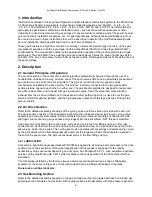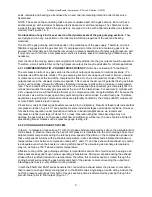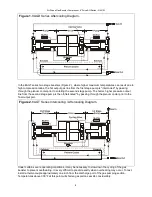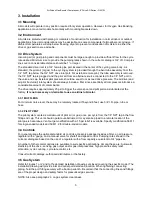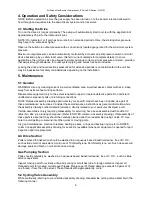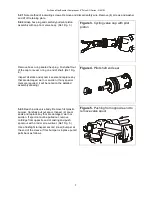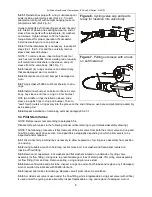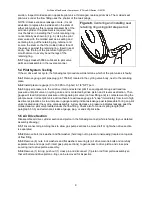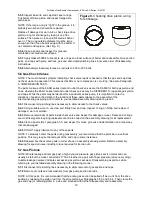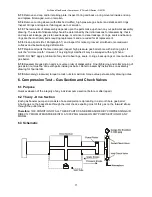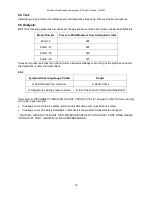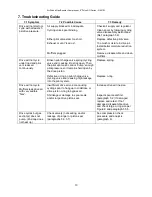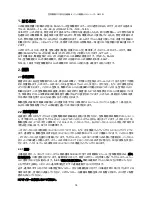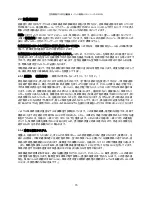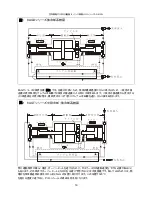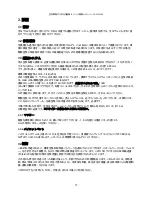
Air Driven Gas Booster Compressor, 8” Drive AG Series • OM-12J
2
1. Introduction
Information contained in these general Operation and Maintenance Instructions pertain to the 8AG Series
Air Driven Gas Booster Compressors. Current basic model designations are: 8AGD-1, -2, -2.8, -5, -14,
-30, -60, -150 and 8AGT-5/14, -5/30, -14/30, -14/60, -30/60, -30/150, and -60/150. The information will
also apply to specialized modifications of standard units
– such as those with special seals or other
materials for uncommon drive media, gas pumped or environmental conditions; and/or those with special
port connections, installed accessories, etc., for special purposes. Although these modifications will not
be covered in detail in these instructions they will be described in detail on the modified assembly/parts
list, and installation drawings attached to each unit at time of shipment.
These gas boosters are high flow, air driven, (normally), reciprocating piston type non-lube, oil-free gas
compressors available in both single stage, double acting (Model 8AGD) and two stage (Model 8AGT)
configurations. The model dash number is the approximate area ratio of the air drive piston area to gas
piston area. Thus an 8AGD-5 has a working air drive area of about 5 times the area of either gas piston
an 8AGT-5/14, an air drive area of about 5 times the area of the first stage and about 14 times the area of
the second stage.
2. Description
2.1 General Principles of Operation
The air, drive piston in the center of the unit reciprocates automatically powered through the use of a
nondetented, unbalanced 4-way, air valve spool. This spool valve shifts by being alternately pressurized
and vented on one end by the pilot air system. The pilot air is controlled by two pilot air valves
mechanically actuated by the drive piston. This air drive is directly connected to the two gas booster
section pistons, opposite each other on either end. The gas booster pistons are designed to reciprocate
dry without lubrication, and to boost inlet gas to desired output - free of hydrocarbon contamination.
Exhaust from the air drive (chilled due to the expansion after performing work) is used to cool the gas
piston barrels (through the jackets), and the high pressure output and interstage gas lines (through the
plenum cooler).
2.2 Air Drive Section
Refer to the detailed assembly drawings of the cycling valve and drive section provided with each unit.
The drive section consists of the drive piston assembly; the unbalanced spool type 4-way cycling valve
assembly and two pilot stem valves. Porting consists of a drive inlet port, two large exhaust ports; plus
pilot input, pilot vent and a gauge access port (plugged) into the pilot system. NPT thread is standard.
One pilot valve is located in the control valve end cap and one in the flow fitting end cap. A flow tube
connects drive air flow from the valve end cap to the opposite end cap, and a pilot tube connects the two
pilot valves, which are in series. The cycling spool valve operates without springs or detents and is cycled
by the pilot valves which alternately pressurize and vent the large area inside the pilot piston inserted in
the end of the spool valve. The pilot vent exhaust port is in the flow fitting end cap.
2.2.1 LUBRICATION
At assembly, light silicone grease (Haskel P/N 50866) is applied to all moving parts and seals (in the drive
section only-not gas sections). Occasional reapplication of this grease is suggested to the readily
accessible cycling spool seals depending on duty cycle. See Paragraph 5.2.3.1. Also available is extreme
service cycling modification No. 54312 which enables continuous operation of the drive without further
lubrication.
If not otherwise installed by the factory, always install a conventional bowl type, shop air filter/water
separator of the same or larger size on the incoming air drive plumbing and maintain it regularly.
Do not use an airline lubricator.
2.3 Gas Boosting Section
Refer to the detailed assembly drawing on the gas pumping section(s) provided with each unit. Each gas
pumping section consists of a gas barrel with cooling jacket, piston assembly with high pressure dynamic
Содержание Haskel 8AGD-1
Страница 15: ...8 OM 12J 15 2 3 T 2 3 1 4 25 1 8AGT 8AGD 40 1 10 1 2 3 2 3 1 5 1 10 1 80 C...
Страница 16: ...8 OM 12J 16 1 8AGD 8AGT 2 8AGT 25mm 145 C...
Страница 18: ...8 OM 12J 18 3 5 1 2 2 3 4 4 1 1 bar 5 5 1 CV No 242 CV O...
Страница 19: ...8 OM 12J 19 IPA 50 50 5 2 5 2 1 5 2 2 3 O O 4 5 2 3 5 3 4 5...
Страница 24: ...8 OM 12J 24 O 5 7 8 5 7 9 6 6 1 6 2 70 bar 6 3...
Страница 25: ...8 OM 12J 25 6 4 6 5 6 5 1 bar 8AGD 5 15 5 8AGD 14 15 5 8AGD 30 17 2 8AGD 60 21 7 6 5 2 A A B B B 5 5 34 5 bar...
Страница 26: ...8 OM 12J 26 7 7 1 7 2 7 3 1 4 bar 5 2 O O O 9 5 5 5...
Страница 28: ...8 AG OM 12J 28 2 3 T 1 2 2 3 1 psi 0 4 25 1 0 2 8AGT 2 8AGD Haskel 40 1 10 1 2 3 2 3 1 5 1 10 1 150 F...
Страница 29: ...8 AG OM 12J 29 8AGD 8AGT 8AGD 1 2 1 1 8AGD 8AGT 2 2 1 2 2 2 8AGT...
Страница 31: ...8 AG OM 12J 31 3 5 1 2 2 3 4 4 1 15 psi 5 5 1 Loctite CV Blue 242 Loctite CV O...
Страница 32: ...8 AG OM 12J 32 Stoddard 50 50 5 2 5 2 1 4 5 2 2 3 O O 4 3 4 Pilot shaft end seal...
Страница 38: ...8 AG OM 12J 38 B 80 500 psi 7 7 1 7 2 7 3 20 psi 5 2 O O 9 5 5 6 O 6...
Страница 41: ...8 AG OM 12J 41 1 8AGD 8AGT 2 2 8AGT 1 300 F...
Страница 43: ...8 AG OM 12J 43 4 1 15 PSI 5 5 1 Loctite CV 242 Loctite CV O 50 50 5 2 5 2 1...
Страница 44: ...8 AG OM 12J 44 5 2 2 3 O O 4 5 2 3 5 5 2 3 1 O 2 2 1 6 30 5 2 4 5 2 1 5 2 3 3 4 5 6...
Страница 48: ...8 AG OM 12J 48 5 7 3 O 5 7 4 O O 5 7 5 O 5 7 6 5 1 5 7 7 O 5 7 8 5 7 9 6 6 1 6 2 1000 PSlG 6 3...
Страница 49: ...8 AG OM 12J 49 6 4 6 5 6 5 1 PSlG 8AGD 5 225 8AGD 14 225 8AGD 30 250 8AGD 60 315 6 5 2 A A B B B 80 500 PSI...
Страница 50: ...8 AG OM 12J 50 7 7 1 7 2 7 3 20 psi 5 2 O O 9 5 5 5 O 6...


